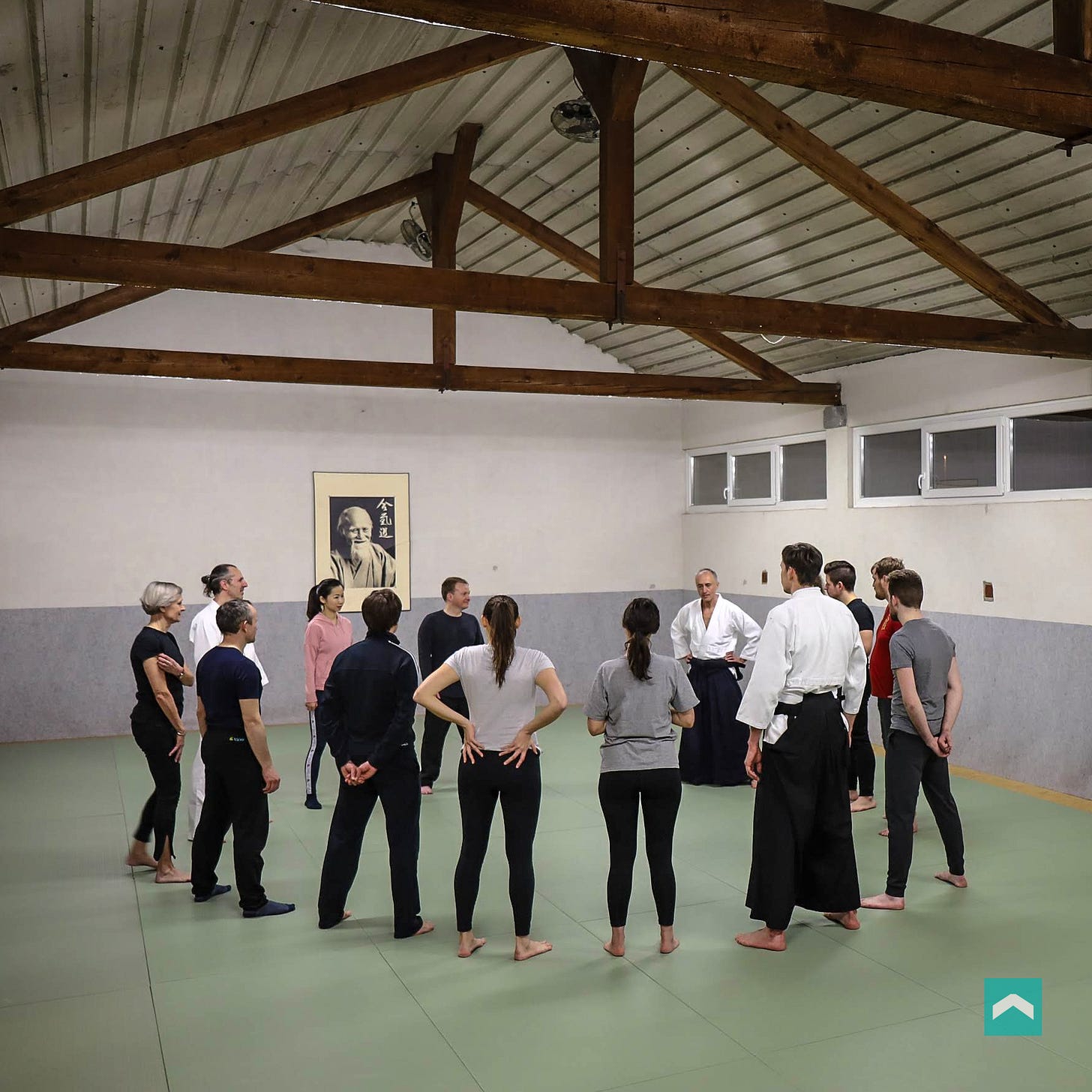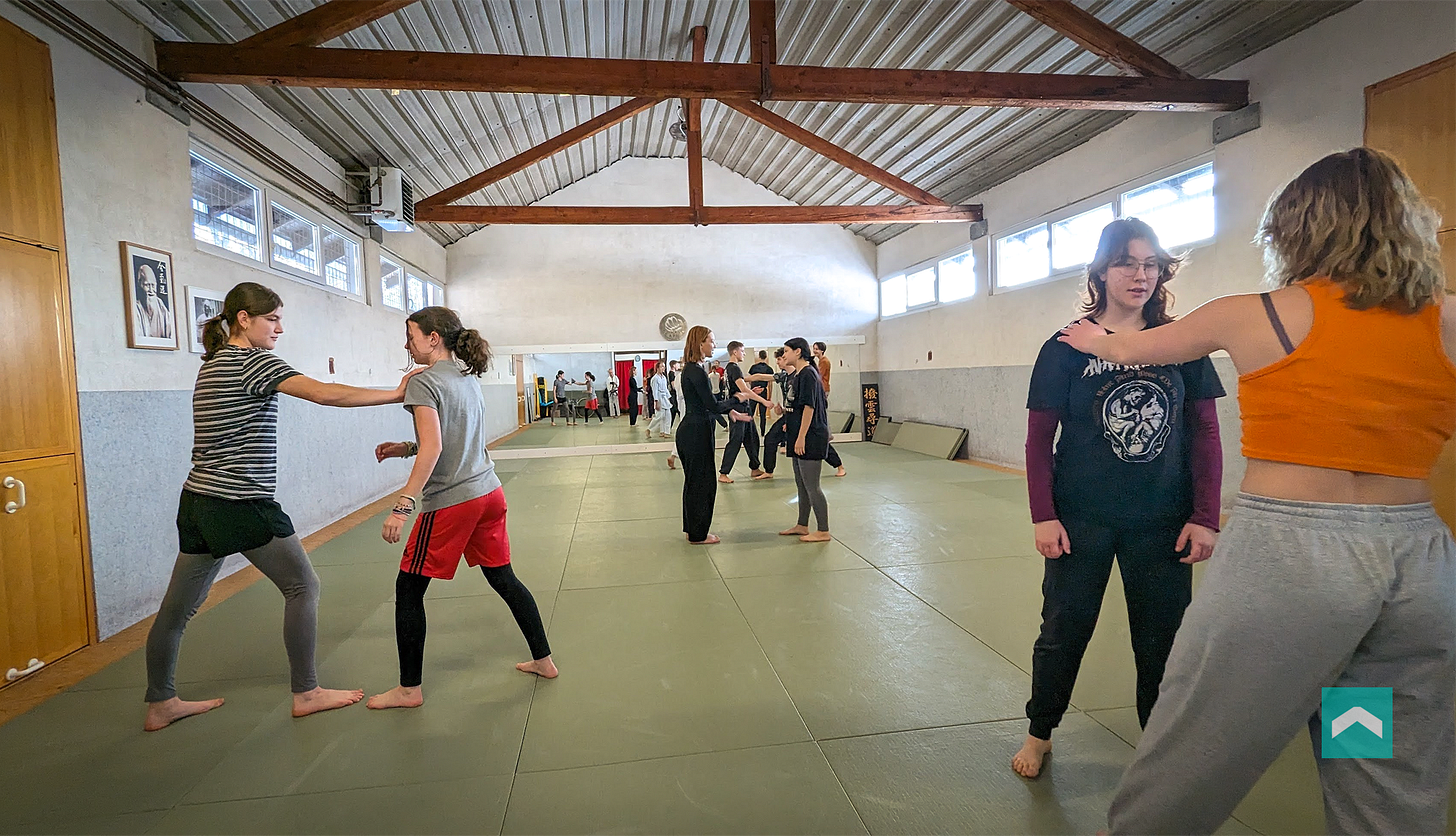Why consultants charge €1,500 for what you teach for €30
How aikido instructors can bridge the gap between authentic practice and real-world application.
While aikido dojos worldwide struggle with declining enrollment and aging demographics, there's a massive market opportunity hiding in plain sight. The global corporate training industry reached $345 billion in 2023 and is projected to hit $493 billion by 2028.
In Europe alone, companies spend over €60 billion annually on leadership development, stress management, and conflict resolution training.
Here's the problem: Most of this money flows to consultants who rarely step on a mat but confidently sell aikido wisdom they've never embodied. Meanwhile, aikido instructors—who have 20+ years of actual experience with presence under pressure, non-violent conflict resolution, and adaptive leadership—watch from the sidelines as their dojos are empty.
According to industry research, business consultants charge €1,500 per day or more for watered-down versions of what you teach for €30-40 per class. They've taken pieces of our art, packaged them in corporate language, and built thriving consultancies while authentic teachers struggle to pay dojo rent.
Time to explore new territory.
Why authentic aikido experience beats business school theory
Corporate training companies promise to teach executives how to stay centered under pressure, resolve conflicts without escalation, and lead through influence rather than force. Sound familiar?
You've been teaching these exact skills for decades. The difference is, you've actually embodied them. You know what it feels like to maintain composure when someone's trying to throw you. You understand how to blend with aggressive energy instead of meeting it head-on. You've learned to find stability in movement and strength through relaxation.
Most business consultants teach these concepts as intellectual frameworks. You teach them as lived experience.
My accidental discovery
I stumbled into corporate training by accident. A colleague asked if I could run a leadership workshop for a small startup. I had exactly one month to prepare and no idea what I was doing.
I borrowed lesson plans from another instructor and decided to test some basic exercises with my regular aikido students. I was terrified they'd think I was wasting their time with "corporate nonsense." Instead, I got the opposite reaction.
I only spent 10-15 minutes per class experimenting with corporate applications—centering exercises, some sword work translated into "presence and intention" concepts. Nothing complicated, and I made sure not to interfere with our regular curriculum.
"Wow, so cool,"
one student said afterward,
"something I can actually use at work."
This experimentation helped me understand how to better balance explaining techniques versus principles in my regular classes too. The corporate workshop went better than expected. Simple centering exercises, basic partner work adapted for business clothes, some discussion about conflict as energy rather than enemy. They loved it. More importantly, it worked. The principles translated perfectly—I just had to change the language.
The methodology that proves it works
In 2020, I developed an anti-bullying methodology based on aikido principles that received official EU funding and recognition through the SkillAi project. The framework is now scaled up to SkillAiPlus—good practices on how to use Aikido to efficiently cope with different types of bullying and aggression in schools.
When aikido principles get translated properly, institutions pay attention. The methodology works because it's grounded in decades of practical experience, not theoretical models.
But my biggest learning came from an unexpected source: teenagers.
Discovering new perspectives
I once ran a week-long aikido introduction for gymnasium students—3 hours per day of basic aikido practice. They were just doing it for fun, not seeking personal transformation or life-changing wisdom.
I was surprised by how curious and engaged this generation turned out to be. Without the formal structures we use in traditional dojos, they approached the movements with fresh eyes and genuine interest.
The experience made me realize how different our perception inside the aikido community is from how outsiders view the Aikido brand. What we consider essential elements, they saw as optional details. What we think defines the art, they experienced as one way among many to explore movement and awareness.
This insight became crucial for understanding how to communicate aikido's value to people who've never stepped on a mat—something I'll explore more in the upcoming Marketing-do series.
Building confidence in your existing skills
Why you're more qualified than you think.
What companies actually need (and what you already teach)
Leadership presence under pressure ✓
You teach this every time a student learns to maintain composure during randori
Conflict resolution without domination ✓
Core aikido principle—neutralize the attack, preserve the person
Stress management through embodied awareness ✓
Centering practice, breath work, finding stability in movement
Team dynamics based on harmony ✓
Every partner exercise teaches this—mutual benefit over competition
Adaptive decision-making under uncertainty ✓
That's exactly what happens when someone grabs you and you have to respond appropriately
Communication that builds rather than breaks relationships ✓
The essence of blending—meet people where they are, guide them where they need to go
Corporate trainers charge thousands to teach these concepts as theory. You've been embodying them as practice.
I understand your concerns
"But I don't know anything about business..."
Neither did I when I started. The principles transfer directly—you just change the language from "uke and nage" to "team dynamics."
"My students would think I'm selling out..."
My students became more engaged with their aikido practice after seeing practical applications. It actually enhanced their understanding of what we were doing.
"I don't have corporate connections..."
Every parent in your dojo works somewhere. Every adult student has colleagues dealing with workplace stress and conflict. Your network is bigger than you think.
"What if I fail?"
You've been teaching strangers to fall safely and get back up for years. Teaching executives to stay centered under deadline pressure is actually easier.
"This sounds like diluting aikido..."
It's the opposite. It's proving that aikido works exactly as advertised—as a practical art for dealing with real-world challenges.
Your next steps
This is just the beginning of the conversation. Over the coming months, I'll be sharing practical frameworks specifically for aikido teachers ready to expand their impact beyond the dojo:
Marketing language that translates aikido principles into clear business benefits
Lesson plan templates for common workplace scenarios
Interview with someone who does it - Mark Walsh (aka Mr. Embodiment), known for teaching coaches embodiment with 15+ years experience and author of 7 books
Download now: Full 8-page program with everything included: essential preparation steps, key success factors, common mistakes & fixes, plus TWO complete workshop outlines: "Centering under pressure" and "Conflict as energy". These tested frameworks translate authentic aikido principles into practical corporate training modules.
The methodology is proven. The market demand is massive. The only question is whether authentic aikido teachers will step up to meet it, or continue watching from the sidelines while others profit from diluted versions of our art.
The bigger picture
This isn't just about extra income, though that matters when dojo membership is declining. It's about proving that aikido works exactly as advertised: as a practical art for dealing with real-world challenges.
The corporate world needs what aikido actually offers - the practical wisdom of staying centered under pressure, resolving conflict through understanding, and leading through influence rather than force.
You've spent years learning to embody these principles. The question isn't whether you're qualified to teach them, it's whether you're ready to translate them for people who need them.
Because the art's future might depend on how well we can explain its value to people who've never stepped on a mat.
What's been your experience with applying aikido principles outside the dojo? Have you considered corporate applications? Share your thoughts in the discussion below.






Looking for new outlets and streams of income is one way of doing it. But in my opinion there is a more fundamental, core issue with Aikido which needs to be addressed. Martial Arts have progressively become more and more aggressive, especially with MMA. It has become a spectacle rather than a spiritual practice, and now YouTube is full of videos showing Aikido masters losing to boxers, MMA fighters etc. Aikido faces a communication issue at its core. It needs to readdress its place as a martial art in modern society against its “competitors,” if it is to succeed in new teaching venues outside of the traditional dojo. In many respects it’s no different than people spending millions of dollars a year on power yoga but few will ever take initiation in Kriya Yoga.